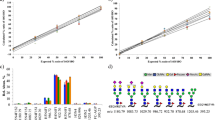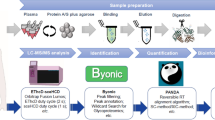Abstract
Gaucher disease, the most common lysosomal metabolic disorder, can be treated with enzyme replacement therapy (ERT). Recombinant human glucocerebrosidase imiglucerase (Cerezyme®), produced in Chinese hamster ovary cells, has been used for ERT of Gaucher disease for 20 years. Another recombinant glucocerebrosidase velaglucerase alfa (VPRIV), expressed in a human fibroblast cell line, was approved by the US Food and Drug Administration in 2010. The amino acid sequence difference at residue 495 of these two products is well documented. The overall N-linked qualitative glycan composition of these two products has also been reported previously. Herein, employing our recently developed approach utilizing isobaric tandem mass tag (TMT) labeling and an LTQ Orbitrap XL electron transfer dissociation (ETD) hybrid mass spectrometer, the site-specific glycoforms of these products were identified with ETD and collision-induced dissociation (CID) spectra. The quantitative comparison of site-specific glycans was achieved utilizing higher-energy collisional dissociation (HCD) spectra with a NanoMate used as both a fraction collector and a sample introduction device. From the trypsin-digested mixture of these two products, over 90 glycopeptides were identified by accurate mass matching. In addition to those previously reported, additional glycopeptides were detected with moderate abundance. The relative amount of each glycoform at a specific glycosylation site was determined based on reporter signal intensities of the TMT labeling reagents. This is the first report of site-specific simultaneous qualitative and quantitative comparison of glycoforms for Cerezyme® and VPRIV. The results demonstrate that this method could be utilized for biosimilarity determination and counterfeit identification of glycoproteins.




Similar content being viewed by others
References
Kacher Y, Brumshtein B, Boldin-Adamsky S, Toker L, Shainskaya A, Silman I, et al. Acid beta-glucosidase: insights from structural analysis and relevance to Gaucher disease therapy. Biol Chem. 2008;389(11):1361–9. doi:10.1515/BC.2008.163.
Beutler E, Grabowski GA. Gaucher disease. In: Scriver CR, Sly WS, editors. The metabolic and molecular bases of inherited disease. New Yourk: McGraw-Hill Inc.; 2001. p. 3635–68.
Edmunds T. β-Glucocerebrosidase ceredase and Cerezyme. In: McGrath BM, Walsh G, editors. Directory of therapeutic enzymes. Boca Raton: CRC Press; 2006. p. 117.
Brumshtein B, Salinas P, Peterson B, Chan V, Silman I, Sussman JL, et al. Characterization of gene-activated human acid-beta-glucosidase: crystal structure, glycan composition, and internalization into macrophages. Glycobiology. 2010;20(1):24–32. doi:10.1093/glycob/cwp138.
Aerts JM, Yasothan U, Kirkpatrick P. Velaglucerase alfa. Nat Rev Drug Discov. 2010;9(11):837–8. doi:10.1038/nrd3311.
Hollak CE, vom Dahl S, Aerts JM, Belmatoug N, Bembi B, Cohen Y, et al. Force majeure: therapeutic measures in response to restricted supply of imiglucerase (Cerezyme) for patients with Gaucher disease. Blood Cells Mol Dis. 2010;44(1):41–7. doi:10.1016/j.bcmd.2009.09.006.
Wei RR, Hughes H, Boucher S, Bird JJ, Guziewicz N, Van Patten SM, et al. X-ray and biochemical analysis of N370S mutant human acid beta-glucosidase. J Biol Chem. 2011;286(1):299–308. doi:10.1074/jbc.M110.150433.
Van Patten SM, Hughes H, Huff MR, Piepenhagen PA, Waire J, Qiu H, et al. Effect of mannose chain length on targeting of glucocerebrosidase for enzyme replacement therapy of Gaucher disease. Glycobiology. 2007;17(5):467–78. doi:10.1093/glycob/cwm008.
Brooks SA. Appropriate glycosylation of recombinant proteins for human use: implications of choice of expression system. Mol Biotechnol. 2004;28(3):241–55. doi:10.1385/MB:28:3:241.
Warnock JN, Al-Rubeai M. Bioreactor systems for the production of biopharmaceuticals from animal cells. Biotechnol Appl Biochem. 2006;45(Pt 1):1–12. doi:10.1042/BA20050233.
Mukovozov I, Sabijicl T, Hortelano G, Ofosu FA. Factors that contribute to the immunogenicity of therapeutic recombinant human proteins. Thromb Haemost. 2008;99(5):874–82. doi:10.1160/Th07-11-0654.
Haller CA, Cosenza ME, Sullivan JT. Safety issues specific to clinical development of protein therapeutics. Clin Pharmacol Ther. 2008;84(5):624–7. doi:10.1038/clpt.2008.158.
Kawasaki N, Itoh S, Hashii N, Takakura D, Qin Y, Huang X, et al. The significance of glycosylation analysis in development of biopharmaceuticals. Biol Pharm Bull. 2009;32(5):796–800.
Rudd PM, Elliott T, Cresswell P, Wilson IA, Dwek RA. Glycosylation and the immune system. Science. 2001;291(5512):2370–6.
Liszewski K. Exploiting post-translational modifications. Genet Eng News. 2005;25(1):22.
Dwek RA, Butters TD, Platt FM, Zitzmann N. Targeting glycosylation as a therapeutic approach. Nat Rev Drug Discov. 2002;1(1):65–75. doi:10.1038/Nrd708.
Helenius A, Aebi M. Intracellular functions of N-linked glycans. Science. 2001;291(5512):2364–9.
Okuyama N, Ide Y, Nakano M, Nakagawa T, Yamanaka K, Moriwaki K, et al. Fucosylated haptoglobin is a novel marker for pancreatic cancer: a detailed analysis of the oligosaccharide structure and a possible mechanism for fucosylation. Int J Cancer. 2006;118(11):2803–8. doi:10.1002/ijc.21728.
Kyselova Z, Mechref Y, Al Bataineh MM, Dobrolecki LE, Hickey RJ, Vinson J, et al. Alterations in the serum glycome due to metastatic prostate cancer. J Proteome Res. 2007;6(5):1822–32. doi:10.1021/pr060664t.
Kayser V, Chennamsetty N, Voynov V, Forrer K, Helk B, Trout BL. Glycosylation influences on the aggregation propensity of therapeutic monoclonal antibodies. Biotechnol J. 2011;6(1):38–44. doi:10.1002/biot.201000091.
Sola RJ, Griebenow K. Glycosylation of therapeutic proteins: an effective strategy to optimize efficacy. BioDrugs. 2010;24(1):9–21. doi:10.2165/11530550-000000000-00000.
Berg-Fussman A, Grace ME, Ioannou Y, GA G. Human acid β-glucosidase N-glycosylation site occupancy and the effect of glycosylation on enzymatic activity. J Biol Chem. 1993;268(20):14861–66.
Varki A, Kornfeld S. The spectrum of anionic oligosaccharides released by endo-beta-N-acetylglucosaminidase H from glycoproteins. Structural studies and interactions with the phosphomannosyl receptor. J Biol Chem. 1983;258(5):2808–18.
Raju TS, Briggs JB, Chamow SM, Winkler ME, Jones AJ. Glycoengineering of therapeutic glycoproteins: in vitro galactosylation and sialylation of glycoproteins with terminal N-acetylglucosamine and galactose residues. Biochemistry. 2001;40(30):8868–76.
Salinas PA, Miller MJC, Lin MX, Savickas PJ, Thomas JJ. Mass spectrometry-based characterization of acidic glycans on protein therapeutics. Int J Mass Spectrom. 2012;312:122–34. doi:10.1016/j.ijms.2011.06.017.
Takasaki S, Murray GJ, Furbish FS, Brady RO, Barranger JA, Kobata A. Structure of the N-asparagine-linked oligosaccharide units of human placental beta-glucocerebrosidase. J Biol Chem. 1984;259(16):10112–7.
Tekoah Y, Tzaban S, Kizhner T, Hainrichson M, Gantman A, Golembo M, et al. Glycosylation and functionality of recombinant ss-glucocerebrosidase from various production systems. Bioscience reports. 2013;33(5):doi:10.1042/BSR2013008.
Ye H, Boyne 2nd MT, Buhse LF, Hill J. Direct approach for qualitative and quantitative characterization of glycoproteins using tandem mass tags and an LTQ Orbitrap XL electron transfer dissociation hybrid mass spectrometer. Anal Chem. 2013;85(3):1531–9. doi:10.1021/ac3026465.
Peterman SM, Mulholland JJ. A novel approach for identification and characterization of glycoproteins using a hybrid linear ion trap/FT-ICR mass spectrometer. J Am Soc Mass Spectrom. 2006;17(2):168–79. doi:10.1016/j.jasms.2005.10.008.
http://ca.expasy.org/tools/glycomod, (6/2/2014).
https://prosightptm2.northwestern.edu, (6/2/2014).
Dvir H, Harel M, McCarthy AA, Toker L, Silman I, Futerman AH, et al. X-ray structure of human acid-beta-glucosidase, the defective enzyme in Gaucher disease. EMBO Rep. 2003;4(7):704–9. doi:10.1038/sj.embor.embor873.
Morelle W, Canis K, Chirat F, Faid V, Michalski JC. The use of mass spectrometry for the proteomic analysis of glycosylation. Proteomics. 2006;6(14):3993–4015. doi:10.1002/pmic.200600129.
Alley Jr WR, Mechref Y, Novotny MV. Characterization of glycopeptides by combining collision-induced dissociation and electron-transfer dissociation mass spectrometry data. Rapid Commun Mass Spectrom. 2009;23(1):161–70. doi:10.1002/rcm.3850.
Viner RI, Zhang T, Second T, Zabrouskov V. Quantification of post-translationally modified peptides of bovine alpha-crystallin using tandem mass tags and electron transfer dissociation. J Proteomics. 2009;72(5):874–85. doi:10.1016/j.jprot.2009.02.005.
Acknowledgments
The authors gratefully acknowledge receipt of materials from Genzyme Corporation (Cerezyme®) and Shire Human Genetic Therapies, Inc. (VPRIV) which were used in this work. The work performed in the study was supported in part by the FDA Critical Path grant program awarded to H. Ye.
Disclaimer
The findings and conclusions in this article have not been formally disseminated by the Food and Drug Administration and should not be construed to represent any agency determination or policy.
Author information
Authors and Affiliations
Corresponding author
Rights and permissions
About this article
Cite this article
Ye, H., Hill, J., Gucinski, A.C. et al. Direct Site-Specific Glycoform Identification and Quantitative Comparison of Glycoprotein Therapeutics: Imiglucerase and Velaglucerase Alfa. AAPS J 17, 405–415 (2015). https://doi.org/10.1208/s12248-014-9706-4
Received:
Accepted:
Published:
Issue Date:
DOI: https://doi.org/10.1208/s12248-014-9706-4




